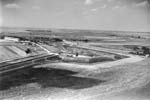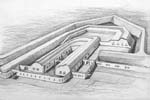
|
The Vaag Line
was built in the 1860’s, almost 20 years
after the building of the Palatine Line. It
is reflected in the conception and solution
of its construction. Influenced by the
Austrian-Prussian war in 1866, the building
work speeded up. The chain of
fortifications consists of six main fort
elements (VI., VII., VIII., IX., X., XI.
ramparts – batteries), out of which only the
first two are considered as bastions (VI.,
VII. ramparts). The Vaag Line compared with
the Palatine Line is more modest in its
design because of its location as it spreads
along the river Vaag. The river actually
represented an advanced defence zone. The
walls which connect the fortifications are
also simpler. A tall, steep earthen rampart
forms the defence line towards the town, it
is then followed by a water ditch which is
bordered by a fort wall from the inner side.
Loopholes based in the stone walls face the
ditches. Except from the loopholes, the
protection of the ditch lengthwise was also
ensured due to the heavy artillery casemates
based in the sides of bastions VI and VII.
The heavy artillery casemates which connect
the fifth and sixth bastions played a
similar role. The walls of the Vaag Line are
also repeatedly broken from the seventh
bastion towards the central fortress because
the gun-emplacements based in the bays
ensured the protection of the walls
lengthwise. This section is divided by
buildings with simple, symmetrical and
rectangular groundplans and narrow courts.
We can conclude from the openings in the
buildings [entrance, windows, ventilation]
that they were mainly used as arsenals. The
cannons were placed in the four big halls of
the building. The entrance gates of the
building led to the court. The four smaller
rooms of the building most probably served
as quarters for the commanders and the
guards. The windows of these rooms
overlooked the town. Only those parts of the
arsenal which overlooked the town served as
quarters for the soldiers.

|
The gate and some casemates of the last, the
eleventh rampart of the Vaag Line, survived
in good state. Its function was to close the
defence line and at the same time connect
the external ramparts of the New Fortress
with the Vaag Line. An earthen rampart
spread from the right wing of the New
Fortress towards the confluence of the
Danube and Vaag rivers. It went as far as
the eastern bastion of the Old Fortress. In
the inner part of the Vaag Line, between the
eighth and ninth ramparts, an independent
rampart was built which was marked as VIII
½. This battery position, which could be
approached from two ramps, enabled one to
shoot at further points in the forefield,
thus increasing the efficiency of defence
of the Vaag Line.
|